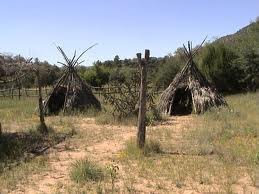Native American Cairn or Rock Burial
The next mode of interment to be considered is that of cairn or rock burial, which has prevailed and is still common to a considerable extent among the tribes living in the Rocky Mountains and the Sierra Nevadas. Illustration of American Indian Burials
In the summer of 1872 the writer visited one of these rock cemeteries in Middle Utah, which had been used for a period not exceeding fifteen or twenty years. It was situated at the bottom of a rock slide, upon the side of an almost inaccessible mountain, in a position so carefully chosen for concealment that it would have been almost impossible to find it without a guide. Several of the graves were opened, and found to have been constructed in the following manner: A number of bowlders had been removed from the bed of the slide until a sufficient cavity had been obtained; this was lined with skins, the corpse placed therein, with weapons, ornaments, &c., and covered over with saplings of the mountain aspen; on the top of these the removed bowlders were piled, forming a huge cairn, which appeared large enough to have marked the last resting place of an elephant. In the immediate vicinity of the graves were scattered the osseous remains of a number of horses which had been sacrificed, no doubt, during the funeral ceremonies. In one of the graves, said to contain the body of a chief, in addition to a number of articles useful and ornamental, were found parts of the skeleton of a boy, and tradition states that a captive boy was buried alive at this place.
From Dr. O. G. Given, physician to the Kiowa and Comanche Agency, Indian Territory, the following description of burial ceremonies was received. According to this gentleman the Kiowas call themselves Kaw-a-wāh, the Comanches Nerm, and the Apaches Tāh-zee.
They bury in the ground or in crevices of rocks. They do not seem to have any particular rule with regard to the position. Sometimes prone, sometimes supine, but always recumbent. They select a place where the grave is easily prepared, which they do with such implements as they chance to have, viz, a squaw-axe, or hoe. If they are traveling, the grave is often very hastily prepared and not much time is spent in finishing. I was present at the burial of Black Hawk, an Apache chief, some two years ago, and took the body in my light wagon up the side of a mountain to the place of burial. They found a crevice in the rocks about four feet wide and three feet deep. By filling in loose rocks at either end they made a very nice tomb. The body was then put in face downwards, short sticks were put across, resting on projections of rock at the sides, brush was thrown on this, and flat rocks laid over the whole of it.
The body of the deceased is dressed in the best clothing, together with all the ornaments most admired by the person when living. The face is painted with any colored paint they may have, mostly red and yellow, as I have observed. The body is then wrapped in skins, blankets, or domestic, with the hands laid across the breast, and the legs placed upon the thighs. They put into the grave their guns, bows and arrows, tobacco, and if they have it a blanket, moccasins, and trinkets of various kinds. One 143or more horses are killed over or near the grave. Two horses and a mule were killed near Black Hawk’s grave. They were led up near and shot in the head. At the death of a Comanche chief, some years ago, I am told about seventy horses were killed, and a greater number than that were said to have been killed at the death of a prominent Kiowa chief a few years since.
The mourning is principally done by the relatives and immediate friends, although any one of their own tribe, or one of another tribe, who chances to be passing, will stop and moan with the relatives. Their mourning consists in a weird wail, which to be described must be heard, and once heard is never forgotten, together with the scarifying of their faces, arms, and legs with some sharp instrument, the cutting off of the hair, and oftentimes the cutting off of a joint of a finger, usually the little finger (Comanches do not cut off fingers). The length of time and intensity of their mourning depends upon the relation and position of the deceased in the tribe. I have known instances where, if they should be passing along where any of their friends had died, even a year after their death, they would mourn.
The Shoshones, of Nevada, generally concealed their dead beneath heaps of rocks, according to H. Butterfield, of Tyho, Nye County, Nevada, although occasionally they either burn or bury them. He gives as reasons for rock burial: 1st, to prevent coyotes eating the corpses; 2d, because they have no tools for deep excavations; and 3d, natural indolence of the Indians—indisposition to work any more than can be helped.
The Pi-Utes, of Oregon, bury in cairns; the Blackfeet do the same, as did also the Acaxers and Yaquis, of Mexico, and the Esquimaux; in fact, a number of examples might be quoted. In foreign lands the custom prevailed among certain African tribes, and it is said that the ancient Balearic Islanders covered their dead with a heap of stones, but this ceremony was preceded by an operation which consisted in cutting the body in small pieces and collecting in a pot.Native American Burial Rituals and Superstitions


















.jpg)
















